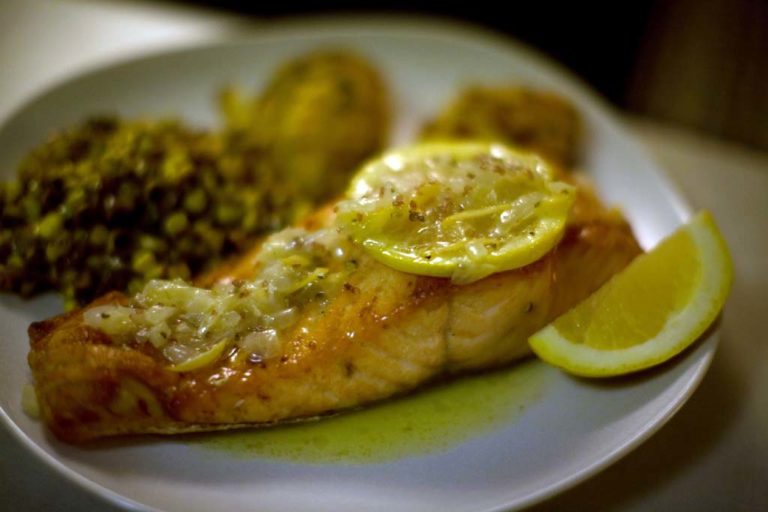
Chef's notes:
Growing up in northern Minnesota, I didn’t get the opportunity to eat salmon very often. I come from walleye country. But, just a little to the east of me in Lake Superior, there live salmon. So, it was not long before I started eating salmon once in a while and, more importantly, cooking with it. I quickly learned that the salmon is a very versatile and durable fish. It has almost as many applications as cod. But it tastes better and is a lot better for you.
My favorite way to cook salmon fillets is in the broiler with the skin on. I like the broiler because it is similar to the grill, except it is inverted and inside. But the effect is similar, as they both cause crusty caramelization of the exterior of the fish. Broilers are feared and under-used. They are very simple to operate. Read on.
Ingredients
- 2 farm-raised salmon fillets
- Sea salt
- White pepper
- Vegetable oil
Broiled Salmon Fillet: Seasoned with Salt, Pepper and Served with a Lemon Butter
- Preheat the broiler and prep the salmon fillets. To broil salmon, or anything else, you will need some sort of broiling pan. A broiling pan has a top piece with slits cut in it for the juice to drip through into the reservoir below. Place an oven rack about 5–6 inches below the broiler unit. Turn the broiler on high and let it warm up for a few minutes. While the broiler is warming up, season the salmon fillets with sea salt, white pepper, and a little vegetable oil. Brush a little oil onto the broiling pan, too.
- Broil the first side. Once the broiler is up to heat you can put the salmon in on the first side. Keep an eye on it for the first few minutes, as all broilers are not created equal. If you have a hood fan/vent, it would be a good idea to turn it on now. If the salmon is burning, lower the broiler setting to medium. Depending on the thickness of your fillets, broiling on medium for the duration may be a good idea. Once the first side is nice and browned, you are ready to broil the other side.
- Broil the other side. Using an oven mitt, pull the oven rack out of the oven. Using a pair of spring-loaded tongs, flip the fillet over to cook the other side. Push the rack back into the oven. It will take approximately the same amount of time to cook this side. Most importantly, once you think the salmon is done, use a digital thermometer to make sure the internal temperature is at least 161 degrees F. Once internal temp has been achieved, remove the salmon and let it rest for a few minutes.
- Let the salmon rest; time to make a quick sauce. Take the salmon off the broiling pan and let it rest on a cool surface for five minutes. Salmon is a very flavorful fish, and it will be delicious just the way it is served with a slice of lemon. Or you can also make a simple lemon butter sauce like we did here. The recipe is up on the right of the screen. Enjoy!
Tips & Tricks
- Salmon with the skin on will be easier to handle and won’t fall apart as easily.
- Almost all Atlantic salmon is farm raised, where as almost all Pacific salmon is wild caught.
Lemon Butter Sauce Recipe
- 3 Tbsp minced onion
- 1 Tbsp olive oil
- Pinch sea salt
- White pepper
- 5 slices of lemon
- 4 Tbsp butter
- 1 Tbsp lemon juice
Sauté the onions in the olive oil until they turn translucent; add the lemon slices, salt, pepper, and lemon juice. Turn off the heat and mix the butter in. Serve.
